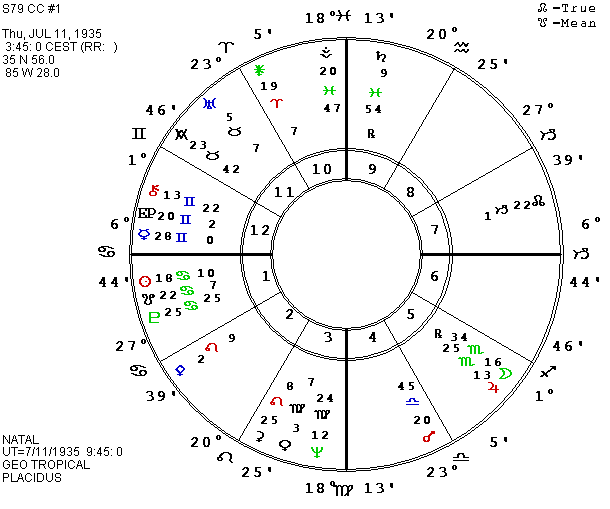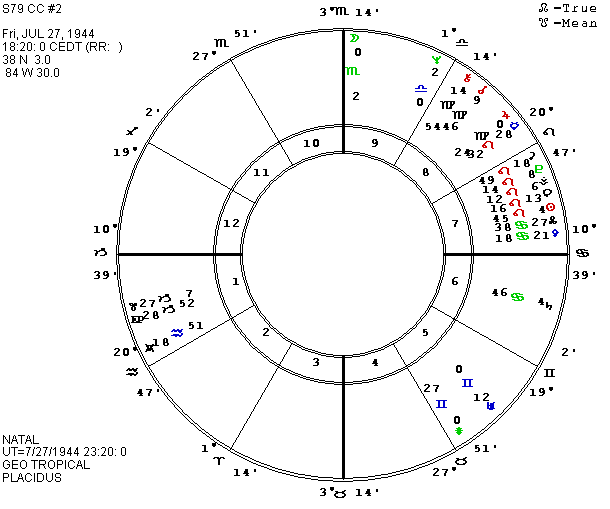Challenge Corner
Zip Dobyns
Unless I missed some of my mail due to my wanderings, we did not have any responses to our Virgo challenge. I suspect it was because of the work involved in doing current patterns for two dates for two sets of angles. Even with the computer, it still took time to write in and study the event positions in the charts of the twins. Yet I think this is an easier judgment for astrology than simply judging character from the natal chart. I was especially interested in this challenge because it offered an opportunity to test quotidian house cusps, that is the ones that make a complete circle in the year (calculated from the sidereal time corresponding to the specific time of day you interpolate to to progress a chart for a specific date in a year). In the past, I have found the most dependable system of progressing angles to be directing the MC by the solar arc (distance of the progressed Sun from the natal Sun) and then looking up the other angles (Ascendant, Antivertex, East Point) for that directed MC. An alternate possible technique is to move all angles by the solar arc, which I do when using solar arc directions on all planets. Still another technique calculates the progressed angles from the sidereal time of the progressed date (one day after birth for each year of life), but using the original birth time. I had not found the latter as dependable as adding the solar arc to the MC. Daily angles provide a whole new dimension to progressions. I am now trying the combination of the two systems, and the Virgo challenge seems to demonstrate the potential usefulness of both.
We must remember, in considering the charts, that both twins would be emotionally touched by the death of a niece or nephew, though certainly not as closely as by the death of their own child. For the first death on December 27, 1961, the first-born twin had progressed Mars and Juno conjunct her progressed MC; progressed Ascendant quincunx progressed Moon (which was opposite Saturn and Vesta progressed in both twins’ charts); her progressed EP was octile-tri-octile the Saturn-Vesta-Moon combination, while her progressed Antivertex squared natal Saturn and was tri-octile the Mars-Juno-MC group. The combination certainly looks strong enough to justify severe emotional strain, especially when we add the Quotidian Ascendant tri-octile natal Saturn, the Q. Antivertex octile the south node of the Moon in the 5th house. But the Q. MC is just past the opposition to natal Mars, and the Q. EP is just past the square to natal Ceres. Seeing the Saturn-Vesta-Moon just short of the Ascendant axis, one would naturally consider putting the birth time just a couple of minutes earlier which would bring all those aspects into one degree orb.
Looking at the later twin for the same event, we find P. MC conjunct P. Venus, which is octile, tri-octile the Saturn-Vesta-Moon combination, and the P. MC is also still in orb to a quincunx to P. Ceres in the 4th house. Then we note P. Ascendant conjunct natal Moon and quincunx Chiron; P. EP octile and tri-octile the Ascendant-Chiron opposition; and P. Antivertex quincunx natal Mars and tri-octile progressed Neptune. Q. MC is conjunct natal Ceres in the 4th house, and Ceres is a key to mothering. Q. Ascendant is octile P. Moon, our other key to mothering. Q. EP is tri-octile natal Vesta. Q. Antivertex is quincunx natal Vesta, opposite natal EP, and octile P. Uranus. All the quotidian angles are involved, without changing the birth time, plus the rulers of the 5th house are all involved in the aspects.
Turning next to the later death in June 1979, we have even more complications with two dates for quotidian angles, since we have a date for the auto accident and another for the death. Looking first at the earlier twin, we find the P. MC opposite Uranus; P. Ascendant tri-octile natal Venus and opposite natal Ceres for the death. Q Ascendant started square natal Ceres and moved to conjunct P. Jupiter which opposed the 8th cusp. Q. Antivertex started tri-octile Chiron and moved to conjunct the P. Moon which squared the P. nodes of the Moon.
Examining the chart of the later twin for this later event, we see P. MC quincunx P. Chiron, and octile natal Mars; P. Ascendant has no obvious aspects. P. EP is trine Chiron and sextile natal Ascendant; P. Antivertex is again without obvious aspects except for a sextile to Uranus. Q. MC moves from the opposition to Ceres to a quincunx to P. Uranus; Q. Ascendant moves from a square to P. Ceres to no obvious aspect. Q. EP moves from a conjunction to P. Jupiter to a square to P. Neptune; Q. Antivertex moves from a conjunction to the P. Moon to a square to Uranus. Again, there are aspects in both, but the progressed angles are certainly less drastic in this case than they were for Agnes. Based on this much data, I would be inclined to pick the later twin for the first death and the earlier twin for the second, and that is the correct answer. An additional clue to the earlier twin being the twin for the second death could come from P. Saturn conjunct her Ascendant (which was actually there for years) and from P. Venus just moved on to her 12th house cusp. The movement of the Sun from a natal opposition to the IC to a progressed trine can also be significant. Repeatedly, I have seen the progressed aspect indicate the timing of an event, while the natal aspect showed the nature of the event: in this case, separation from a child.
We have focused on the “event” aspects, and not on character, which is contrary to our usual policy, so before leaving the charts, what can we see that could symbolize the character that could lead to separation from a child? A couple of possibilities are obvious in the charts. There is a clear tension between domesticity and independence and career shown by the strong Cancer and Leo which wants home and family, especially when added to 4th and 5th house activity, with Ceres in the 4th. Yet the loaded 10th house is driven to achieve something bigger in life than just family; Saturn conjunct Ascendant (though wide) says it again; and the Uranus in the 5th is often a sign of someone who wants children but not many so they can recover their own freedom. The south node of the Moon in the 5th just shows a lesson in that area, but we have to look to the sign, aspects, and the rest of the chart to determine what kind of lesson. In Pisces, it may symbolize the over-idealization of the child or the mother-role, and sometimes we have to lose something to find out it is not God. Saturn, ruling the Aquarius 5th cusp and in the Pisces house repeats the latter theme, especially with its quincunx to the node and Uranus. Yet there is a grand water trine in the chart, suggesting great fertility and need for emotional relationships. So the need is to integrate career, family, and at least a little space for personal independence because whatever is totally denied is apt to be pushed into the unconscious where it proceeds to get us what we didn’t know we wanted. And, also, it is important to love and enjoy the family but not to feel we must be the perfect mother of perfect children. The Scorpio emphasis in the chart rather repeats that theme; the need to learn to love and let go. We may do it voluntarily, or we may have to learn it the hard way, by having something taken away from us. No one ever said it was easy—learning how to juggle 12 sides of life. We can only do the best we can, and then trust that it will work out. It is important to remember that learning is always a shared lesson when people play out a mutual dilemma, whether it is parent-child, husband-wife, siblings, or whatever. We do not “cause” anything to happen to anyone, but we do learn our own lessons from and with the important “others” in our lives.


For our Challenge in this issue of The Mutable Dilemma, we have two unrelated people instead of our usual twins. Their birth data is: #1 July 11, 1935; 3:45 CST; 35 N 56; 85 W 28 and #2 July 27, 1944; 18:20 CWT; 38 N 3; 84 W 30. Both of these females had the same illness. One went through the usual medical treatment and eventually died. The other changed her attitudes and the illness disappeared; doctors call it “spontaneous remission,” but mostly lack the time, understanding, or interest to pursue the causes behind it. Both were ill in 1978. One died in 1979. With that extra clue, do we have any brave readers who want to guess which is which?